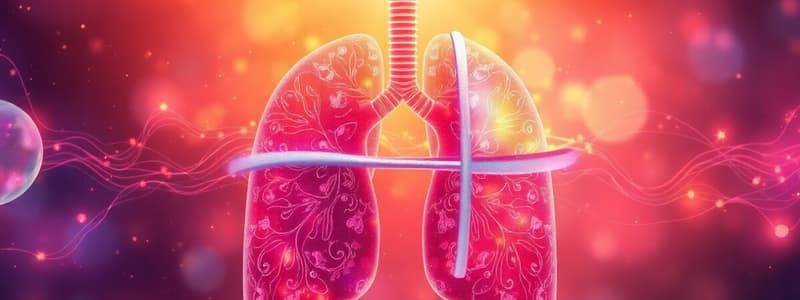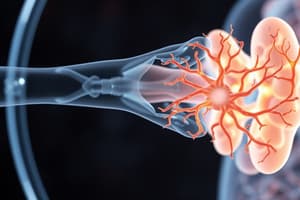Podcast
Questions and Answers
What physiological condition is primarily characterized by high airway resistance and can limit exercise performance?
What physiological condition is primarily characterized by high airway resistance and can limit exercise performance?
- Bronchial asthma
- Chronic obstructive pulmonary disease (COPD) (correct)
- Pulmonary hypertension
- Interstitial lung disease
During intense exercise, what is the primary mechanism that allows for increased oxygen offloading from hemoglobin?
During intense exercise, what is the primary mechanism that allows for increased oxygen offloading from hemoglobin?
- Increased sympathetic outflow
- Decreased capillary density
- High partial pressure of O2 in venous blood
- Short transit time due to high vascularization (correct)
What factor is considered a primary determinant of oxygen transport in the blood?
What factor is considered a primary determinant of oxygen transport in the blood?
- Hemoglobin concentration (correct)
- Capillary permeability
- Cardiac output
- Blood volume
Which of the following statements accurately reflects the oxygen saturation and delivery during exercise?
Which of the following statements accurately reflects the oxygen saturation and delivery during exercise?
What is the effect of increased pulmonary pressure on cardiac output during exercise?
What is the effect of increased pulmonary pressure on cardiac output during exercise?
Which factor does NOT influence the extent of gas dissolving into a fluid according to Fick's law of diffusion?
Which factor does NOT influence the extent of gas dissolving into a fluid according to Fick's law of diffusion?
What is the primary reason CO2 can exchange efficiently with a small pressure gradient?
What is the primary reason CO2 can exchange efficiently with a small pressure gradient?
Which statement correctly describes the relationship between the partial pressures of O2 and CO2 in the lungs?
Which statement correctly describes the relationship between the partial pressures of O2 and CO2 in the lungs?
What effect does an increase in temperature have on the Bohr effect?
What effect does an increase in temperature have on the Bohr effect?
What is the primary form of carbon dioxide transport in the blood?
What is the primary form of carbon dioxide transport in the blood?
Which physiological factor does NOT affect the oxygen concentration in systemic arterial blood?
Which physiological factor does NOT affect the oxygen concentration in systemic arterial blood?
What primarily defines the oxygen saturation (SaO2) in arterial blood?
What primarily defines the oxygen saturation (SaO2) in arterial blood?
Which of the following factors contributes to the production of 2,3 DPG in red blood cells?
Which of the following factors contributes to the production of 2,3 DPG in red blood cells?
Which mechanism is NOT one of the three buffering mechanisms mentioned for maintaining acid-base balance?
Which mechanism is NOT one of the three buffering mechanisms mentioned for maintaining acid-base balance?
How does altitude affect exercise performance as measured by VO2 max?
How does altitude affect exercise performance as measured by VO2 max?
Flashcards are hidden until you start studying
Study Notes
Gas Exchange: Fick's Law
- Diffusion of CO2 & O2 is influenced by pressure gradient, solubility, temperature, and time
- Exercise can affect these factors and alter diffusion.
Partial Pressure
- Defined as the pressure exerted by each gas in a mixture, if it alone occupied the total volume.
- Dalton's Law states: Partial Pressure of a gas = [Gas] x Total Pressure of gas mixture
Pressure Gradients for O2 and CO2: Alveolus to Blood
- Alveolar PO2 (PAO2) is approximately 100 mmHg, lower than in atmosphere (~159 mmHg) due to water evaporation and CO2 diffusion.
- Oxygen diffuses from alveoli into blood, driven by this pressure gradient.
Oxygen Transport in Blood
- Arterial oxygen content is influenced by inspired oxygen, ventilation, gas exchange, hemoglobin concentration & affinity.
- Content (CaO2) measured in mL O2/100mL blood, while saturation (SaO2) reflects % of hemoglobin binding sites occupied.
- Oxygen-hemoglobin dissociation curve illustrates relationship between SaO2 and PO2.
Arterial Desaturation during Exercise
- Can occur in various scenarios like COPD with impaired gas exchange and elite athletes with high oxygen offloading.
- Reasons for desaturation:
- Shorter transit time, high vascularization in athletes.
- Ventilation-perfusion mismatch at high intensities.
- Increased oxygen delivery and high pressure gradient, leading to rapid offloading.
Arteriovenous Oxygen Difference (a-vO2 diff)
- Represents the difference in oxygen content between arterial and venous blood.
- Varies significantly at rest versus intense exercise, especially in active muscles.
Limiting Factors for Exercise Performance
- Pulmonary factors can limit exercise:
- Desaturation of O2.
- High airway resistance (like in COPD).
- Pulmonary pressure effects on cardiac output.
- High work of breathing, leading to respiratory muscle fatigue & increased sympathetic outflow.
CO2 Transport
- Transported in three forms:
- 5% dissolved in plasma, tightly regulated, drives ventilation at rest.
- 20% bound to hemoglobin.
- 60-80% as bicarbonate, which acts as a buffer to maintain pH.
Acid-Base Buffering
- Buffers resist changes in pH.
- Bicarbonate accepts H+ ions, releasing CO2, which is expelled by the lungs.
- Three buffering mechanisms: Chemical, pulmonary ventilation and renal function.
Exercise at Altitude
- Above 2100m, exercise performance is significantly impacted.
- While % oxygen remains constant, atmospheric pressure decreases with altitude, affecting PO2.
- PO2 drops linearly with altitude.
Altitude Responses
- Responses are proportional to altitude level.
- Acute responses are cardiorespiratory, including increased HR and ventilation.
- Adaptive responses include peripheral changes: muscle oxidative changes, increased RBC production.
Early Responses to Altitude
- Increased ventilation to drive more O2 into the blood.
- Respiratory alkalosis due to decreased buffering capacity.
- Increased HR, but HRmax may decrease.
- Increased a-vO2 difference to offload more O2.
- Increased 2,3-DPG to facilitate oxygen offloading.
- Decreased plasma volume, leading to increased oxygen concentration.
- Increased EPO production, potentially leading to increased Hb and red cell volume.
Exercise Performance at Altitude: Physiology
- Decreased PO2, leading to a smaller pressure gradient for gas exchange.
- Shift in oxygen dissociation curve to the right to enhance oxygen offloading.
- Decreased performance due to:
- Increased HR and VE.
- Impaired buffering capacity, resulting in respiratory alkalosis.
- Reduced cardiac output.
- Overall, less oxygen delivery to skeletal muscle.
Summary
- Pulmonary factors like desaturation, airway resistance, and work of breathing can limit exercise performance.
- O2 and CO2 transport differ significantly, with CO2 diffusing and dissolving more readily than O2.
- Altitude significantly impacts exercise performance by affecting PO2, resulting in a smaller pressure gradient and reduced oxygen delivery to skeletal muscle.
Studying That Suits You
Use AI to generate personalized quizzes and flashcards to suit your learning preferences.




